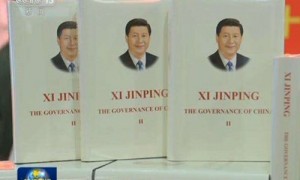"There is a good start to get the United States involved," Amitav Acharya, UNESCO chair in Transnational Challenges and Governance and distinguished professor of International Relations at American University, told Xinhua in a recent interview in Beijing.
"And it would be fantastic," he said.
Proposed by China in 2013, the Belt and Road Initiative comprises the Silk Road Economic Belt and the 21st Century Maritime Silk Road, aiming to build a trade and infrastructure network connecting Asia, Africa and Europe along ancient trade routes. Over the past three-plus years, the initiative has witnessed continuous expansion of its "friend circle," and yielded tangible benefits for countries on its routes.
Beijing will hold the Belt and Road Forum for International Cooperation on May 14-15, so far with 28 heads of state and government leaders and more than 80 leaders of international organizations attending.
Although Acharya said that under the current circumstances in U.S. domestic politics, engagement in the initiative might not going to be easy, he believed it would be possible to think of solutions.
"One thing would be to get the American private sector involved in the Belt and Road (Initiative), because there are a lot of American private companies that may invest in it," Acharya gave one of his solutions.
To elaborate his point, Acharya said the move would widen the scope of the Belt and Road, which means "not just infrastructure but also to develop some industrial projects where the U.S. companies can invest."
"If you bring the U.S. companies (in), you're giving much more room for U.S.-China cooperation," said Acharya, "It's not just about road, not just about trains, it's also about other types of human infrastructure like hospitals, colleges or universities."
He also suggested that the first step is to build an airport, and the next step could be building an airline or a hospital along the Belt and Road, "if it is defined broadly."
"If you invite American universities to build, for example, in Kazakhstan or along the Belt and Road, they would probably come in. It doesn't need a government-to-government agreement," he added.
Acharya stressed that aside from that general initiative, it can actually help build confidence if getting the United States involved in the AIIB, because "the AIIB is a multilateral institution, and will be more in keeping with U.S. ideology."
Not avoiding the difficulties or challenges, Acharya pointed out that it would take time to build up the level of trust that was needed to get the United States involved in the AIIB and the Belt and Road. "I think we can see common ground potential for win-win situations."
To enhance trust between the two countries, Acharya said that after the leaders' meeting in April, the United States and China are making progress in managing some of the outstanding trade issues. He was referring to the meeting held between Chinese President Xi Jinping and U.S. President Donald Trump at the Mar-a-Lago resort in Florida of the United States in early April.
"That's a good step," he said.
"They (China and the United States) will keep talking and they will try to find a way to present it to the rest of the world. They will spin it in a way that each side satisfies its domestic constituents," said the professor. "I don't think problems will disappear but they will be manageable."
Citing statistics, the professor said the two countries are so closely interdependent with China-U.S. trade of half a trillion U.S. dollars. "Then we have a situation where China and the United States have so much interest in each other's economic stability."







